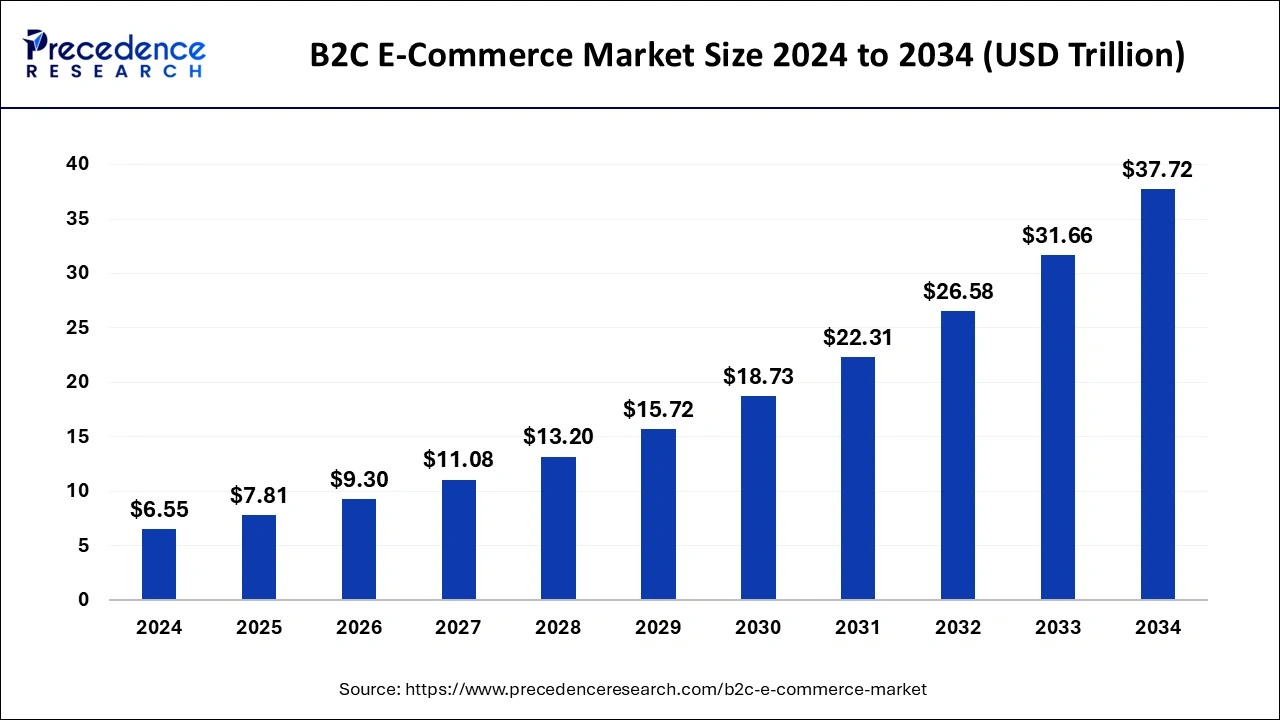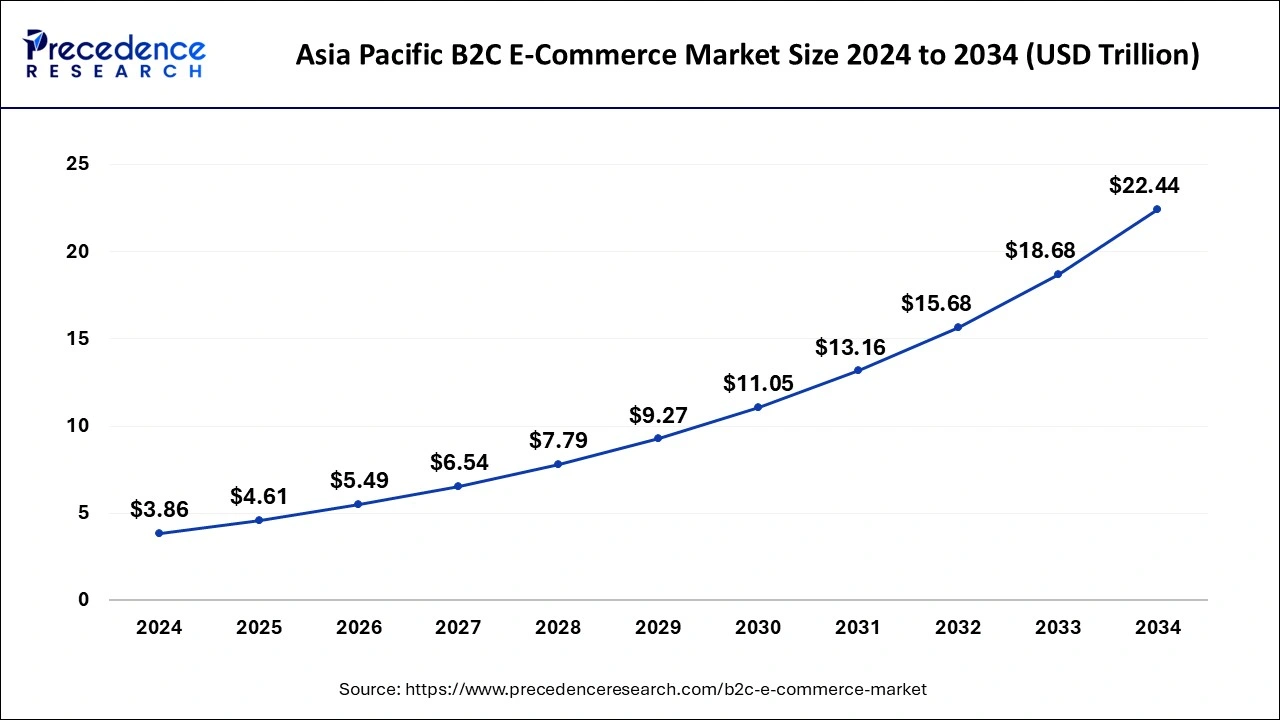July 2024
The global b2c e-commerce market size is calculated at USD 7.81 trillion in 2025 and is forecasted to reach around USD 37.72 trillion by 2034, accelerating at a CAGR of 19.13% from 2025 to 2034. The Asia Pacific market size surpassed USD 3.86 trillion in 2024 and is expanding at a CAGR of 19.25% during the forecast period. The market sizing and forecasts are revenue-based (USD Million/Billion), with 2024 as the base year.
The global b2c e-commerce market size accounted for USD 6.55 trillion in 2024 and is expected to exceed around USD 37.72 trillion by 2034, growing at a CAGR of 19.13% from 2025 to 2034.

The Asia Pacific b2c e-commerce market size was exhibited at USD 3.86 trillion in 2024 and is projected to be worth around USD 22.44 trillion by 2034, growing at a CAGR of 19.25% from 2025 to 2034.

Asia Pacific garnered a market share of around 37% and dominated the global b2c e-commerce market in 2024. Asia Pacific is the home to the world’s largest population. The strong economic growth in the emerging nations like China and India are the major drivers of the Asia pacific b2c e-commerce market. The rising industrialization, rising disposable income, rapidly growing urban population and rapid adoption of the smartphones among the population has boosted the market growth in this region. Moreover, the increased government investments in the development of infrastructure, banking systems, urbanization of rural areas, electrification of rural areas, and internet connectivity are the several factors that has driven the market growth.

North America is estimated to grow at a steady rate throughout the forecast period. North America has the highest internet using population. Moreover, the higher disposable income and increased awareness regarding the various online platforms has propelled the market growth in this region. The Middle East and Africa is expected to be the second-fastest growing market owing to various factors such as rising penetration of internet, growing adoption of smartphones, rising disposable income, and rising adoption of e-commerce platforms.
The global b2c e-commerce market is driven by several factors such as rising disposable income, rising penetration of internet, rising adoption of smartphones, and growing per capita income across the globe. The proliferation of technological advancements has boosted the adoption of smartphones, which has allowed the e-commerce platforms to increase its reach across the every corner of the world. Furthermore, the rising investments in the development of the IT and telecommunications infrastructure has improved the access to the internet and the number of internet users grew rapidly in the past few years across the globe. According to the International Telecommunication Union, there were around 4.9 billion (63% of the global population) internet users by the end of 2021. This number was 4.1 billion in 2019 and it grew rapidly by 782 million in 2 years. Thus the rapid penetration of the internet is significantly boosting the growth of the b2c e-commerce market. Moreover, the surging use of the social media across the globe is playing a crucial role in the revenue generation of the e-commerce platforms. The availability of top e-commerce players such as Amazon, Wal-Mart, eBay, and Flipkart that offers a huge variety of products and brands from the convenience of home to the shoppers along with huge discounts and offers and easy payment, replace, and refund policies has significantly driven the market growth in the past decade
The busy and hectic life schedule of the consumers is a major growth factor for the b2c e-commerce market. Convenience offered by the e-commerce has encouraged the market development and growth. Moreover, the aggressive digital marketing and social media marketing strategies adopted by the key players has contributed towards the market growth. The ease and conveniences associated with online shopping, huge discounts and offers, easy payment options, door step home delivery, easy refund and replacement options, and one-day delivery are some of the important features that has made online shopping popular among the customers. Furthermore, the rapid shift towards m-commerce as most of the user access to the internet through smartphones is a major factor behind the growth of the online shopping. The recent outbreak of the COVID-19 pandemic has significantly boosted the adoption of the e-commerce among the consumers for buying medicines, groceries, and other products. The rapidly growing number of online pharmacies across the globe is expected to boost the market growth significantly in the forthcoming future. Furthermore, the integration of the online shopping and the online payment platforms is supplementing the growth of the market. For instance, Amazon allows payment and shopping through a single application. The online payment apps like Google Pay and Paytm offers huge discounts and cashbacks with online shopping, which has exponentially contributed towards the market growth.
| Report Coverage | Details |
| Market Size in 2025 | USD 7.81 Trillion |
| Market Size in 2034 | USD 37.72 Trillion |
| Growth Rate from 2025 to 2034 |
CAGR of 19.13% |
| Largest Market | Asia Pacific |
| Fastest Growing Market | North America |
| Base Year | 2024 |
| Forecast Period | 2025 to 2034 |
| Segments Covered | Type, Application, Brand Type, Device, Geography |
| Regions Covered | North America, Europe, Asia-Pacific, Latin America, and Middle East & Africa |
Based on the type, the b2c retailers segment accounted for a market share of over 99% and dominated the global b2c e-commerce market in 2024. The increasing urban population, rising volume of online transactions, and growing adoption of various online shopping platforms are the driving factors of this segment. Moreover, a rapid shift in the consumer behavior from traditional to online shopping, improved logistics, ease of doing business, and globalization of businesses are some of the factors that has driven the market growth.
On the other hand, the classifieds is estimated to be the most opportunistic segment during the forecast period. The rising mobile classified advertisements and low cost online advertisements are the growth drivers of this segment.
Based on the application, the clothing & footwear segment dominated the global b2c e-commerce market, garnering a market share of around 25% in 2024. The rapid popularity of the online clothing and footwear retailers across the globe has fueled the growth of this segment. The manufacturers of clothing and footwear are heavily investing in increasing their online presence. The online retailers of clothes provide wide variety of options, easy payment, home delivery, and easy refund and replacement. The user friendly website and easy navigation allows the customers to easily find the desire product and brands, which favors the growth of this segment.
On the other hand, consumer electronics is expected to be the fastest-growing segment during the forecast period. The increased demand for the latest and innovative consumer electronics like smart TV, refrigerator, fans, and air conditioners across the globe coupled with the easy availability of products on online websites and higher product acceptance are the major factors that may be held responsible for the growth of the consumer electronics segment.
The B2C e-commerce market is highly fragmented with the presence of several local and global companies. These market players are striving to gain higher market share by adopting strategies, such as investments, partnerships, and acquisitions & mergers. Companies are also spending on the development of improved products. Moreover, they are also focusing on maintaining competitive pricing.
By Type
By Application
By Brand Type
By Device
By Geography
For inquiries regarding discounts, bulk purchases, or customization requests, please contact us at sales@precedenceresearch.com
No cookie-cutter, only authentic analysis – take the 1st step to become a Precedence Research client
July 2024
December 2024
September 2024
July 2024